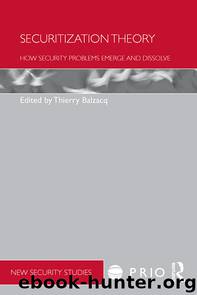Securitization Theory by Balzacq Thierry;

Author:Balzacq, Thierry;
Language: eng
Format: epub
Tags: Social Sciences
Publisher: Taylor and Francis
Published: 2010-08-08T16:00:00+00:00
Policy analysis market
In 2003, a proposal by the Pentagon for a “Policy Analysis Market” (PAM) – in which a crowd of experts would bet, or place a value, on particular targets, tactics, and groups – also failed. In PAM, experts from across government (intelligence, military, diplomacy, and other ‘interested’ parties) would buy and sell stock in particular scenarios – and the market value of these scenarios would reflect their likelihood. The system was not designed to focus on individual acts of terror, but on more abstract measures of stability within the Middle East: “markets were to be created in more mundane events like “How fast will Saudi Arabia’s non-oil gross domestic product grow next year?” or “What chance does Prince so and so have by the end of the year in ascending to the throne in Country X? (Looney 2004: 415). The self-described architect of the PAM, Hanson said that the system was “intended to forecast aggregate measures of geopolitical stability in the Middle East. PAM would have used speculative markets to estimate economic growth, political stability, and military activity four times a year in each of eight nations, and how those measures would depend on each other and on various U.S. policy choices” (2006: 257). Again, different settings saw different degrees of securitization, and in particular different levels of acceptance of the new measures (i.e. betting on terror futures). Amongst behavioral economists and some technologists, the idea was greeted with support (Surowiecki 2004: 79–83; Seife 2003). While the program had been a success within the intelligence community, DARPA, and the Pentagon more widely, it failed in spectacular fashion, once made public by The New York Times and Sens. Wyden and Dorgan on July 28, 2004 and was shut-down by the end of the same day. Within one day of the public announcement of this DARPA program, “newspapers responded by denouncing this ‘unbelievably stupid’ and ‘grotesque’ market. Later that day, the program was officially cancelled” (Meirowitz and Tucker, 2004: 331). Hanson, argues that the cancellation of the program was due to entirely the public and elite perception that betting on terror attacks “crossed a moral boundary,” completely independent of expert analysis of the futures market (2006: 260). There is some scientific evidence that this kind of ideas futures market can have some real predictive capacity, which often exceeds the best guess of any individual or sub-group of experts (Wolfers and Zitzewitz 2004). However, and this is crucial for understanding the importance of difference settings, the experts used politically-sensational examples (the assassination of Arafat and the collapse of the Jordanian monarchy) as their samples to gain funding from the technocrats. The general public and political elite reacted to these examples, and the program was terminated with extreme prejudice within a day of publicity (Abdolian and Takooshian, 2003; Clifton 2003). The theory of behind betting on terror futures and the emergency property of the “wisdom of crowds” essentially tried to securitize economic theory: the terror threat was an emergency and required government action to generate knowledge about the future.
Download
This site does not store any files on its server. We only index and link to content provided by other sites. Please contact the content providers to delete copyright contents if any and email us, we'll remove relevant links or contents immediately.
| Arms Control | Diplomacy |
| Security | Trades & Tariffs |
| Treaties | African |
| Asian | Australian & Oceanian |
| Canadian | Caribbean & Latin American |
| European | Middle Eastern |
| Russian & Former Soviet Union |
The Secret History by Donna Tartt(18163)
The Social Justice Warrior Handbook by Lisa De Pasquale(11954)
Thirteen Reasons Why by Jay Asher(8452)
This Is How You Lose Her by Junot Diaz(6440)
Weapons of Math Destruction by Cathy O'Neil(5832)
Zero to One by Peter Thiel(5494)
Beartown by Fredrik Backman(5359)
The Myth of the Strong Leader by Archie Brown(5239)
The Fire Next Time by James Baldwin(5017)
How Democracies Die by Steven Levitsky & Daniel Ziblatt(4959)
Promise Me, Dad by Joe Biden(4908)
Stone's Rules by Roger Stone(4860)
100 Deadly Skills by Clint Emerson(4691)
A Higher Loyalty: Truth, Lies, and Leadership by James Comey(4552)
Rise and Kill First by Ronen Bergman(4545)
Secrecy World by Jake Bernstein(4389)
The David Icke Guide to the Global Conspiracy (and how to end it) by David Icke(4381)
The Farm by Tom Rob Smith(4324)
The Doomsday Machine by Daniel Ellsberg(4246)
